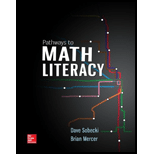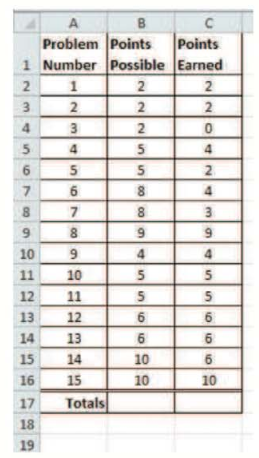
The spreadsheet summarizes the results for one student on a 15-question math test with partial credit awarded.

Complete the totals at the bottom of each column using addition.
To calculate: The total of possible points and points earned in the following table:
| Problem number | Points possible | Points earned |
| 1 | 2 | 2 |
| 2 | 2 | 2 |
| 3 | 2 | 0 |
| 4 | 5 | 4 |
| 5 | 5 | 2 |
| 6 | 8 | 4 |
| 7 | 8 | 3 |
| 8 | 9 | 9 |
| 9 | 4 | 4 |
| 10 | 5 | 5 |
| 11 | 5 | 5 |
| 12 | 6 | 6 |
| 13 | 6 | 6 |
| 14 | 10 | 6 |
| 15 | 10 | 10 |
| Totals |
Answer to Problem 1G
Solution:
The total of possible points is
Explanation of Solution
Given Information:
The provided table shows points earned by a student in
| Problem number | Points possible | Points earned |
| 1 | 2 | 2 |
| 2 | 2 | 2 |
| 3 | 2 | 0 |
| 4 | 5 | 4 |
| 5 | 5 | 2 |
| 6 | 8 | 4 |
| 7 | 8 | 3 |
| 8 | 9 | 9 |
| 9 | 4 | 4 |
| 10 | 5 | 5 |
| 11 | 5 | 5 |
| 12 | 6 | 6 |
| 13 | 6 | 6 |
| 14 | 10 | 6 |
| 15 | 10 | 10 |
| Totals |
Calculation:
The total of possible points is sum of all the numbers in the column of possible points.
That is,
Now, the total earned points is sum of all the numbers in the column of earned points.
That is,
Therefore, total possible is points is
Want to see more full solutions like this?
Chapter 1 Solutions
Pathways to Math Literacy (Loose Leaf)
- No chatgpt pls will upvotearrow_forwardQ/By using Hart man theorem study the Stability of the critical points and draw the phase portrait of the system:- X = -4x+2xy - 8 y° = 4y² X2arrow_forwardThis means that when the Radius of Convergence of the Power Series is a "finite positive real number" r>0, then every point x of the Power Series on (-r, r) will absolutely converge (x ∈ (-r, r)). Moreover, every point x on the Power Series (-∞, -r)U(r, +∞) will diverge (|x| >r). Please explain it.arrow_forward
- Q1: A slider in a machine moves along a fixed straight rod. Its distance x cm along the rod is given below for various values of the time. Find the velocity and acceleration of the slider when t = 0.3 seconds. t(seconds) x(cm) 0 0.1 0.2 0.3 0.4 0.5 0.6 30.13 31.62 32.87 33.64 33.95 33.81 33.24 Q2: Using the Runge-Kutta method of fourth order, solve for y atr = 1.2, From dy_2xy +et = dx x²+xc* Take h=0.2. given x = 1, y = 0 Q3:Approximate the solution of the following equation using finite difference method. ly -(1-y= y = x), y(1) = 2 and y(3) = −1 On the interval (1≤x≤3).(taking h=0.5).arrow_forwardФ sketch stability x= -4x + 2xy - 8 y° = 4 y 2 - x² чуг.arrow_forward2 Q/Given H (x,y) = x² + y² - y² Find the Hamiltonian System and prove it is first integral-arrow_forward
- Q2) A: Find the region where ODEs has no limit cycle: x = y + x³ y=x+y+y³ 6arrow_forwardQ3)A: Given H(x,y)=x2-x+ y²as a first integral of an ODEs, find this ODES corresponding to H(x,y) and show the phase portrait by using Hartman theorem and by drawing graph of H(x,y)-e. Discuss the stability of critical points of the corresponding ODEs.arrow_forwardQ/ Write Example is First integral but not Conservation system.arrow_forward
 Algebra: Structure And Method, Book 1AlgebraISBN:9780395977224Author:Richard G. Brown, Mary P. Dolciani, Robert H. Sorgenfrey, William L. ColePublisher:McDougal Littell
Algebra: Structure And Method, Book 1AlgebraISBN:9780395977224Author:Richard G. Brown, Mary P. Dolciani, Robert H. Sorgenfrey, William L. ColePublisher:McDougal Littell Big Ideas Math A Bridge To Success Algebra 1: Stu...AlgebraISBN:9781680331141Author:HOUGHTON MIFFLIN HARCOURTPublisher:Houghton Mifflin Harcourt
Big Ideas Math A Bridge To Success Algebra 1: Stu...AlgebraISBN:9781680331141Author:HOUGHTON MIFFLIN HARCOURTPublisher:Houghton Mifflin Harcourt Elementary AlgebraAlgebraISBN:9780998625713Author:Lynn Marecek, MaryAnne Anthony-SmithPublisher:OpenStax - Rice University
Elementary AlgebraAlgebraISBN:9780998625713Author:Lynn Marecek, MaryAnne Anthony-SmithPublisher:OpenStax - Rice University


